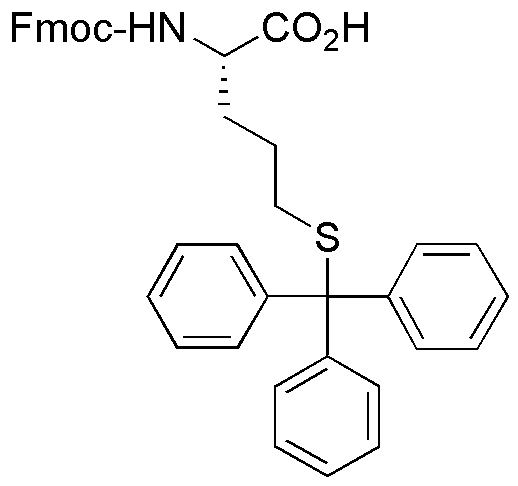(S)-Fmoc-2-amino-5-(tritylthio)-pentanoic acid is widely utilized in research focused on
- Peptide Synthesis: This compound serves as a crucial building block in the synthesis of peptides, particularly in solid-phase peptide synthesis (SPPS). Its protective Fmoc group allows for selective deprotection, making it easier to assemble complex peptide chains.
- Drug Development: The compound is valuable in pharmaceutical research for developing new drugs, especially those targeting specific biological pathways. Its unique structure can enhance the bioavailability and effectiveness of therapeutic agents.
- Bioconjugation: In biochemistry, it is used for attaching peptides to various biomolecules, facilitating the design of targeted drug delivery systems. This application is particularly beneficial in cancer therapy, where precision is crucial.
- Research in Neuroscience: The compound's properties make it suitable for creating peptide-based probes that can interact with specific receptors in the nervous system, aiding in the study of neuropharmacology.
- Protein Engineering: It is employed in the modification of proteins to enhance their stability and functionality. This application is significant in biotechnology, where engineered proteins can be used in diagnostics or therapeutics.
General Information
Properties
Safety and Regulations
Applications
(S)-Fmoc-2-amino-5-(tritylthio)-pentanoic acid is widely utilized in research focused on
- Peptide Synthesis: This compound serves as a crucial building block in the synthesis of peptides, particularly in solid-phase peptide synthesis (SPPS). Its protective Fmoc group allows for selective deprotection, making it easier to assemble complex peptide chains.
- Drug Development: The compound is valuable in pharmaceutical research for developing new drugs, especially those targeting specific biological pathways. Its unique structure can enhance the bioavailability and effectiveness of therapeutic agents.
- Bioconjugation: In biochemistry, it is used for attaching peptides to various biomolecules, facilitating the design of targeted drug delivery systems. This application is particularly beneficial in cancer therapy, where precision is crucial.
- Research in Neuroscience: The compound's properties make it suitable for creating peptide-based probes that can interact with specific receptors in the nervous system, aiding in the study of neuropharmacology.
- Protein Engineering: It is employed in the modification of proteins to enhance their stability and functionality. This application is significant in biotechnology, where engineered proteins can be used in diagnostics or therapeutics.
Documents
Safety Data Sheets (SDS)
The SDS provides comprehensive safety information on handling, storage, and disposal of the product.
Product Specification (PS)
The PS provides a comprehensive breakdown of the product’s properties, including chemical composition, physical state, purity, and storage requirements. It also details acceptable quality ranges and the product's intended applications.
Certificates of Analysis (COA)
Search for Certificates of Analysis (COA) by entering the products Lot Number. Lot and Batch Numbers can be found on a product’s label following the words ‘Lot’ or ‘Batch’.
*Catalog Number
*Lot Number
Certificates Of Origin (COO)
This COO confirms the country where the product was manufactured, and also details the materials and components used in it and whether it is derived from natural, synthetic, or other specific sources. This certificate may be required for customs, trade, and regulatory compliance.
*Catalog Number
*Lot Number
Safety Data Sheets (SDS)
The SDS provides comprehensive safety information on handling, storage, and disposal of the product.
DownloadProduct Specification (PS)
The PS provides a comprehensive breakdown of the product’s properties, including chemical composition, physical state, purity, and storage requirements. It also details acceptable quality ranges and the product's intended applications.
DownloadCertificates of Analysis (COA)
Search for Certificates of Analysis (COA) by entering the products Lot Number. Lot and Batch Numbers can be found on a product’s label following the words ‘Lot’ or ‘Batch’.
*Catalog Number
*Lot Number
Certificates Of Origin (COO)
This COO confirms the country where the product was manufactured, and also details the materials and components used in it and whether it is derived from natural, synthetic, or other specific sources. This certificate may be required for customs, trade, and regulatory compliance.


